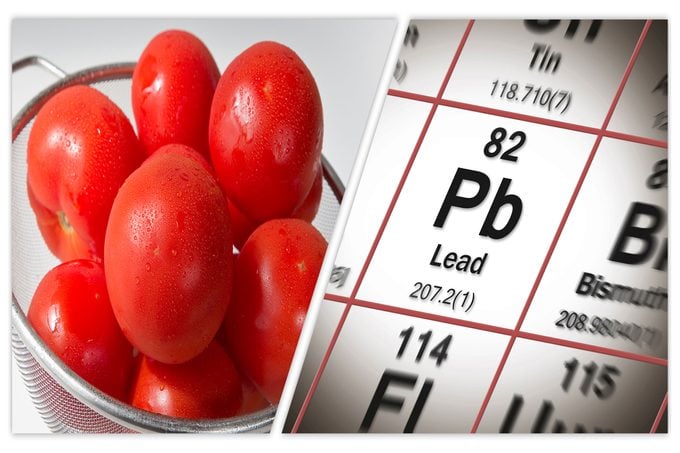The Real Reason Why Tomatoes Were Once Feared
Updated: Feb. 02, 2023

The age-old question, "Are tomatoes poisonous?" has an interesting history. Here's why tomatoes got a bad rap for over two centuries.
Ripe red tomatoes are a fruit so popular that it’s hard to imagine people used to avoid eating them. Of course, the juicy spheres aren’t for everybody—odds are, you know someone who hates tomatoes so much they even avoid tomato sauce on pizza or ketchup on burgers! Pizza, hamburgers, sandwiches, chili, soups, spaghetti and tikka masala all commonly feature tomato—it’s everywhere.
According to market data from Statista, the U.S. per capita consumption of fresh tomatoes in 2021 was 18.8 pounds, which means the average American eats nearly 20 pounds of fresh tomatoes per year. The USDA also shows a loss-adjusted consumption rate of canned tomatoes was even higher than fresh tomatoes in 2019, thanks to popular foods like pizza.
So before you order your next tomato basil panini or a bowl of hot tomato soup from your go-to cafe, stop to think about this mind-blowing thought: people used to fear tomatoes. Why did they? Are tomatoes poisonous? In modern times, we know they’re not, but the history of red fruits might surprise you.
What Is the Origin of Tomatoes?
Before diving into the origin of tomatoes, you may be considering the timeless question: is a tomato a fruit or a vegetable? The answer can get a bit complicated, but scientifically speaking, it’s a fruit. So where did the fruit come from? Well, according to Smithsonian Magazine, tomatoes originated in Mesoamerica and have a history as food for the Aztecs—who called the fruit “tomatl” in their Nahuatl language—as early as 700 AD.
How did tomatoes make their way to Britain? Per the Smithsonian Museum, Spanish conquistadors who traveled to Mesoamerica in the early 16th century are thought to have brought the seeds back from their expeditions, introducing them to Southern Europe. Some researchers believe the famous conquistador Hernan Cortes brought tomato seeds to Europe in 1519—but not for food. People who lived in cooler climates didn’t eat tomatoes until the late 1800s—they only used the plants ornamentally.
There’s a record of the tomato in the British North American Colonies in the 1710 history of plants, Botanologia (penned by herbalist William Salmon). Still, it wasn’t until the 1820s and 1830s that Americans increasingly agreed on tomatoes as food.
Why Were Tomatoes Considered Poisonous?

Are tomatoes poisonous? No, but for a sizable chunk of history, people thought they were. The reason tomatoes received their sullied reputation was a combination problem. First, in the late 1700s, Europeans drew a false connection to dying aristocrats. These ill-fated aristocrats ate tomatoes off pewter plates and often got sick and died after ingesting the red fruit. But the cause of death was actually due to the high lead content of their pewter plates. The acidic tomato leached lead from the plate, which, when consumed, caused lead poisoning. People blamed the fruit rather than the pewter plates.
Another factor in the long history of fear of tomatoes can be traced back to Italian herbalist Pietro Andrae Matthioli. His classification of the tomato as a part of the deadly nightshade family (Solanaceae plants that contain toxic tropane alkaloids) and a mandrake (a group of foods thought to be aphrodisiacs) had repercussions that lasted for over 200 years. This combination, a deadly aphrodisiac, made Europeans believe the fruit was poisonous and a temptation. John Gerard’s Herball did further damage to the tomato’s reputation by erroneously plagiarizing inaccurate information from Dodoens and l’Ecluse’s agricultural works of 1553 and writing that “the whole plant” was “of ranke and stinking savour.” Toxicity exists in the tomato plant’s leaves and stems but not the fruit.
In the United States in the 1830s, people also feared tomato worms as a poisonous threat.
How Did Tomatoes Become Popular Again?
Thanks to the dissipation of old fears and the expansion of scientific knowledge, people began to realize that tomatoes weren’t a threat. Agriculture has much to do with the rise of tomato popularity as farmers began to cultivate different varieties. Meanwhile, fears surrounding tomatoes appeared to fade. By the 1850s, tomatoes had grown immensely popular in America.
With the invention of pizza in Naples, Italy, around 1880, the widespread popularity of tomatoes spread throughout Europe, and the rest is history.
If you’re a tomato lover, you know how to enjoy the fruit. Make sure you know how to store tomatoes to get the most out of their flavor so that not a bit goes to waste.
Sources:






















